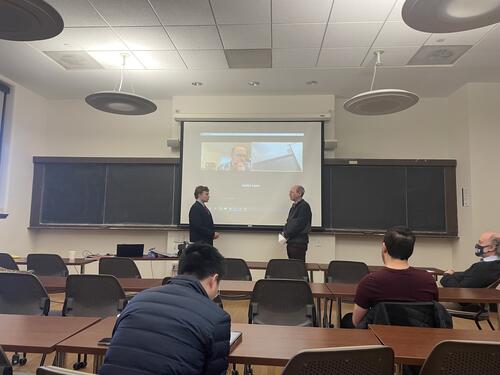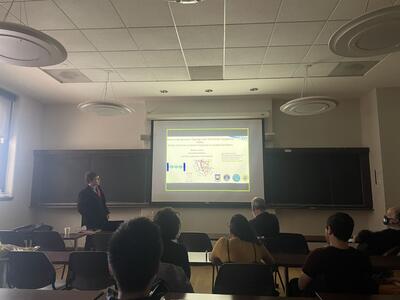
On March 31, 2022, Yale Applied Physics Graduate Student Parker Henry successfully defended his thesis, “Measuring the Knot of Non-Hermitian Degeneracies and Non-Abelian Braids” (Advisor: Jack Harris).
Henry explained, “In recent years, there has been a lot of interest in experiments and devices which incorporate gain, loss, and one-way coupling. These devices have novel applications in sensing and control. They can be realized in any physical domain, including optics, electronics, acoustics, optomechanics, and more. My thesis work studies topological behavior in an optomechanical device, which consists of a silicon-nitride square membrane inside of an optical cavity. The membrane and the cavity interact via cavity photons, which induce a radiation pressure force on the membrane. The topological property I look at is the spectral flow of eigenvalues near system degeneracies at which two of the three eigenvalues coalesce. In my thesis, I find that the spectral flow for this three-mode system has an elegant structure related to the trefoil knot. This work motivates future experiments which use this knot to adiabatically transfer energy between the three eigenmodes.”
Henry is currently applying to research positions at national and industrial labs.
Thesis Abstract: There has been much interest in physical systems that can be described as linear dynamical systems which incorporate gain, loss, and non-reciprocity. Such systems can serve as novel devices in sensing and control applications. They can be realized in any physical domain, including optics, acoustics, electronics, and optomechanics. Systems that incorporate gain, loss, and non-reciprocity are known as “non-Hermitian,” and are distinguished from Hermitian systems by their complex eigenvalues, mode nonorthogonality, and a class of degeneracy known as an exceptional point, for which the dynamical matrix H is nondiagonalizable. Spectral flow presents another distinction between non-Hermitian and Hermitian systems.
Spectral flow is a topological property of the path which the system eigenvalues take in the complex plane C when the system’s parameters are varied around a closed loop. For a Hermitian system, the spectral flow is trivial, since the eigenvalues must return to themselves; for a non-Hermitian system, eigenvalues need not return to the original values. Optomechanics has been used to explore the spectral flow of systems near exceptional points (EPs) for 2-mode systems, for which it is well-understood that spectral flow is determined by how the loop encircles an EP degeneracy. In this thesis, we discuss spectral flow for n-mode systems, and, in an optomechanical platform, experimentally demonstrate the n = 3 case. This case is of interest because the corresponding exceptional point space is a trefoil knot, as opposed to a single point, and because the braid group formed by the spectral flow is non-Abelian. We begin with a pedagogical introduction to exceptional point degeneracies and spectral flow. This introduces the braid group of spectral flow for control loops encircling the exceptional point space.
Next, we employ the optomechanical interaction to define a three-mode non-Hermitian system of mechanical modes, for which we have full control over the parameters that determine the eigenvalues. We describe the optomechanical non-Hermitian platform used in our experiment, which consists of an Si3N4 membrane coupled to a Fabry-Perot cavity in a cryostat, which is driven by two lasers. We show that this system can be brought to a triply degenerate exceptional point (EP3 ). Around this EP3 point, we raster the doubly degenerate exceptional point (EP2 ) subspace on a hypersurface which encloses the EP3 point, and show that this EP2 subspace forms a trefoil knot. Near this EP2 trefoil knot, we execute control loops which achieve spectral flow. We show that these spectral flows realize the non-Abelian braid group B3. Finally, we conclude with a discussion on topological energy transfer between these three modes in a future experiment.
Some photos from the defense:

